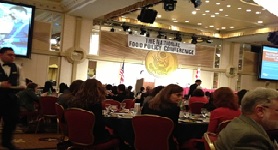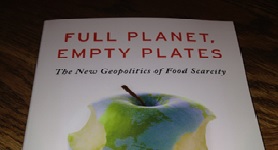By: Thomas Siebertz
…continued from Monday’s (April 22) post….
Communicating About Food Issues In the Age of Social Media
This was one of my favorite panels, not only because I’m a huge fan of Ben Chapman of Food Safety Talks, but also because I felt it was extremely relevant to my career. Linda Eatherton began by presenting research on social media and how it has transformed trends in communication and marketing.
Linda stated that we are in the midst of a permanent power shift in the marketplace. Information is power, but that power is now in the hands of those that create information. Companies used to have authority over the creation of content and had the ability to control the message, particularly in crisis management. Organizations now only create a fraction of the content available to consumers in the social web space.
Today’s consumers are also activists. They are capable of uniting, forming opinions, and changing policy within split seconds. Linda discussed a new type of consumer, called the “food evangelist”. Other names she used for this type of individual were the food snob, the food elitist and the food involved. These people have a very strong impact on our social space and marketplace, and are shaping policy.
Linda went on to describe these “food evangelists” as a group who are financially secure, have children, and are on average 38 years old. They are defined by a psychographic, not a demographic, and participate online at least four times a week, creating content and pushing their opinions out to others about food and agriculture. They are truly unique individuals wanting to be heard and to lead. They are wellness seekers. Although it’s uncertain about how many there are in US or the world, the strength rather than the size of the audience is the important piece.
They also do not like or accept the traditional flow of one-way information of being marketed to. In fact, marketing, education and traditional methodologies of communicating typically bounce off of this group. They are very resistant, listen to everyone, but trust no one. They believe that no one is an expert but themselves. Message is code for marketing and it is the death of communications.
50% of these food evangelists believe that the American food system needs to do a much better job of communicating with the public and 54% assert that transparency must become a priority in food and agriculture business. Companies and organizations must listen first and talk second. Although this defies traditional communication protocols, they can build a relationship daily through sharing and taking actions that demonstrate authenticity and commitment to shared values.
Ben Chapman discussed what he sees in online discussion in relation to risk management. He has spent the last 10 years looking at online discussions about food safety and in 2007 created Barfblog.com with Doug Powell as a social experiment to research the best ways to engage individuals with technical information. Chapman believes that there is an information vacuum between scientific assessment of risk and public perception of risk. Unfortunately this information vacuum can quickly fill with information that may not be evidence-based.
Regardless of whether you are in industry, regulatory or academia, when a potential food safety issue occurs, risk reduction practices and why they are in place must be discussed. There are risks to all foods and more transparency is important so it won’t become a surprise when something goes wrong. That situation is where people end up losing money and credibility.
What social media provides us with are two things: 1. You have lots of access to real people and 2. You know what people are talking about. Though they may not make up the full majority of the thoughts, they are the powerful ones because they are creating content. Building trust, however, is not as simple as having a Twitter feed with the company name on it. People must build trust by showing that they’re a real person with a family. What really works is that someone is engaging somebody, not a company, organization or a regulator. There are some really great people online in different sectors that maybe only 80% of what they produce is food or food safety related. The other 20% is really about what has to do with their personal lives, and that makes them relatable.
Chapman goes on to say that it’s really not worthwhile to shoot out information to where people are not talking about it. Every time we have an outbreak or a recall, there are different types of groups talking about it. You want to go to the places where people are actually talking about it and where the leaders are. Lastly Chapman offered the advice that if you are going to put information out there, make sure it is correct. Every mistake gets amplified. Being part of the conversation and being online is not just about trying to distill what you want to say in 140 characters into a Facebook post, but ensuring its accuracy.
There were excellent points by both Ben and Linda. I am truly grateful for the opportunity to attend this conference, and highly recommend it to other students interested in food policy issues. There were many other panels that I was unable to attend, but I really enjoyed being there and participating in the live twitter discussion.
How do you feel that social media has affected the field of food science? How can we do a better job in communicating with consumers?






Yeah. A huge fan of BEN. So angry. http://25.media.tumblr.com/tumblr_lkbkngBzpv1qz4rlzo1_1280.jpg
I didn’t even get my free beer, how do you think I feel? =[